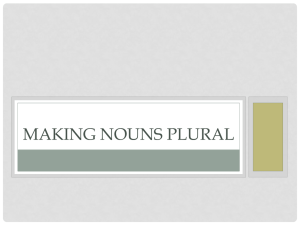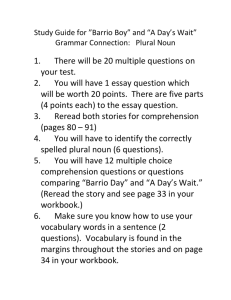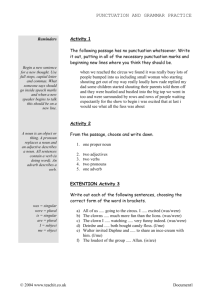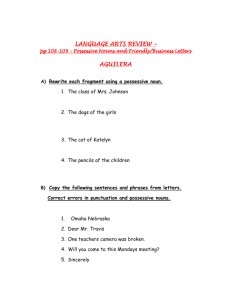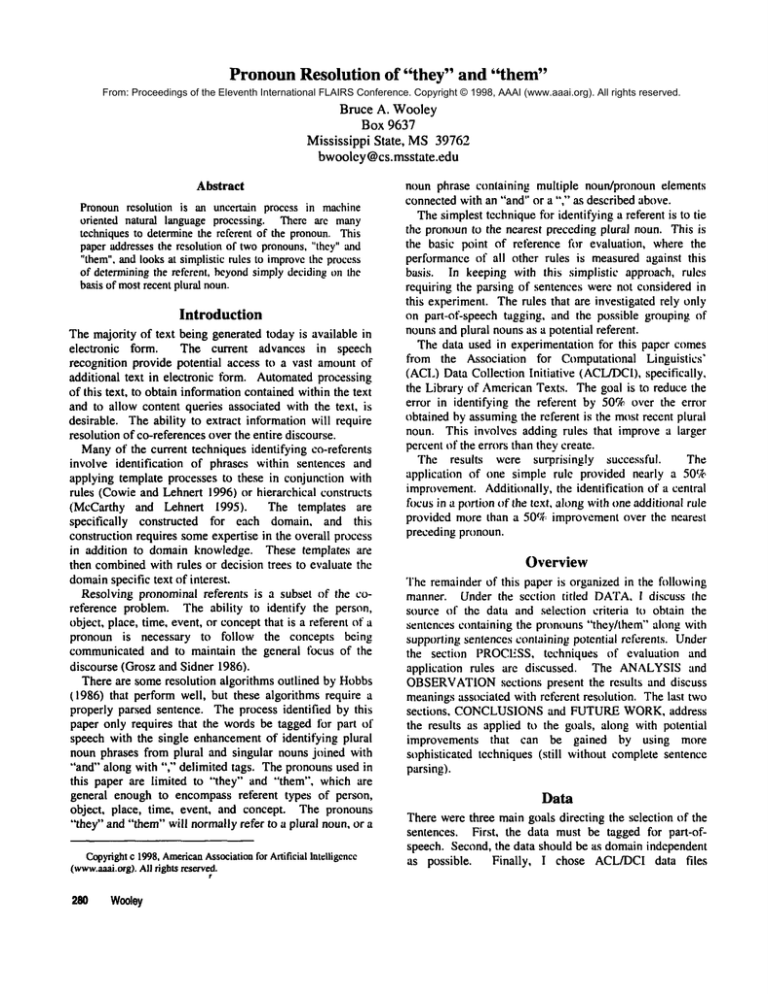
Pronoun Resolution of "they" and "them"
From: Proceedings of the Eleventh International FLAIRS Conference. Copyright © 1998, AAAI (www.aaai.org). All rights reserved.
Bruce A. Wooley
Box 9637
Mississippi State, MS 39762
bwooley@cs.msstate.edu
Abstract
Pronounresolution is an uncertain process in machine
oriented natural language processing. There are many
techniquesto determinethe referent of the pronoun.This
paper addressesthe resolution of twopronouns."they" and
"them".and looks at simplistic rules to improvethe process
of determiningthe referent, beyondsimplydeciding tm the
basis of mostrecent plural noun.
Introduction
The majority of text being generated today is available in
electronic
form. The current advances in speech
recognition provide potential access to a vast amountof
additional text in electronic form. Automatedprocessing
of this text, to obtain informationcontained within the text
and to allow content queries associated with the text, is
desirable. The ability to extract information will require
resolution of co-references over the entire discourse.
Manyof the current techniques identifying co-referents
involve identification of phrases within sentences and
applying template processes to these in conjunction with
rules (Cowie and Lehnert 1996) or hierarchical constructs
(McCarthy and Lehnert 1995). The templates are
specifically
constructed for each domain, and this
construction requires someexpertise in the overall process
in addition to domain knowledge. These templates are
then combinedwith rules or decision trees to evaluate the
domainspecific text of interest.
Resolving pronominal referents is a subset of the coreference problem. The ability to identify the person,
object, place, time, event, or conceptthat is a referent of a
pronoun is necessary to follow the concepts being
communicatedand to maintain the general lbcus of the
discourse (Grosz and Sidner 1986).
There are some resolution algorithms outlined by Hobbs
(1986) that perform well, but these algorithms require
properly parsed sentence. The process identified by this
paper only requires that the words be tagged for part of
speech with the single enhancementof identifying plural
noun phrases from plural and singular nouns joined with
"’and" along with "," delimited tags. The pronounsused in
this paper are limited to "they" and "’them", which are
general enough to encompass referent types of person,
object, place, time, event, and concept. The pronouns
"they" and "them"will normallyrefer to a plural noun, or a
Copyright
c 1998,American
Association
for ArtificialIntelligence
(www.aaai.org).
Allrightsreserverd.
280 Wooley
noun phrase containing multiple noun/pronoun elements
connectedwith an "and" or a "," as described above.
The simplest techniquefor identifying a referent is to tie
the pronounto the nearest preceding plural noun. This is
the basic point of reference for evaluation, where the
performance of all other rules is measuredagainst this
basis. In keeping with this simplistic approach, rules
requiring the parsing of sentences were not considered in
this experiment. The rules that are investigated rely only
on part-of-speech tagging, and the possible grouping of
nounsand plural nounsas a potential referent.
The data used in experimentation for this paper comes
from the Association for Computational Linguistics"
(ACL)Data Collection Initiative (ACI_./DCI),specifically,
the Library of AmericanTexts. The goal is to reduce the
error in identifying the referent by 50%over the error
obtained by assumingthe referent is the most recent plural
noun. This involves adding rules that improve a larger
percent of the errors than they create.
The results were surprisingly successful.
The
application of one simple rule provided nearly a 50%
improvement.Additionally, the identification of a central
fi~cus in a portion of the text, ahmgwith one additional rule
provided more than a 50%improvement over the nearest
preceding pronoun.
Overview
The remainder of this paper is organized in the following
manner. Under the section titled DATA,! discuss the
source of the data and selection criteria to obtain the
sentences containing the pronouns "they/them" along with
supporling sentences containing potential referents. Under
the section PROCI’.’SS, techniques of evaluation and
application rules are discussed. The ANALYSIS
and
OBSERVATION
sections present the results and discuss
meaningsassociated with referent resolution. The last two
sections,
CONCLUSIONS
and FUTUREWORK,address
the results as applied to the goals, along with potential
improvements that can be gained by using more
sophisticated techniques (still without complete sentence
parsing).
Data
There were three maingoals directing the selection of the
sentences. First, the data must be tagged for part-ofspeech. Second, the data should be as domainindependent
as possible. Finally, I chose ACL/DCIdata files
containing a relatively
rich rate of occurrence of
"they/them." The ACL/DCIcorpus provides sentences
that are already tagged. The Penn Treebanktext within the
treebanldpostext directory was chosen because it is generic
(Library of Americantexts) and is tagged. A search of the
files contained within this directory revealed four files
(tl.pos, t2.pos, t4.pos, and t20.pos) that contained more
occurrences of "they/them" than other files in the same
directory.
A program was written to extract sentences from the
corpus to evaluate the effectiveness of the selected rules.
The criteria used for the extraction processes were as
follows. A sentence is included in the study if it contains
at least one of the pronouns being inspected ("they" or
"them"). Additionally, there are supporting sentences
programmatically extracted from the corpus under the
following special situations. If a specific selected sentence
(containing a pronoun "they/them") does not have any
plural nouns preceding this pronoun, then include (as
reference sentence) the sentence immediately prior to the
selected sentence. Additionally, if this included sentence
does not have any plural nouns, then include the sentence
from the corpus that immediately precedes this reference
sentence. The scope of the programlimits the extraction of
these reference sentences to a count of two. If neither of
these supporting sentences contain a plural noun, a manual
inspection of the corpus was needed to find the nearest
prior plural noun. The supporting sentences are not
counted as part of the selections from the corpus. There
were 500 sentences selected and they contained a total of
611 occurrences of "they" or "them", with the patterns of
occurrences as follows: 414 sentences with one (1),
sentences with two (2), 13 sentences with three (3),
sentences with four (4) and 2 sentences with six (6).
Process
After the 500 sentences containing the desired pronouns
along with some reference sentences were selected, the
application of rules to the sentences was done manually.
Twohand modifications of the data were performed. First,
the simple data extraction program did not take textheading cues into consideration. As a consequence, some
titles were included as part of a sentence due to the
extraction programlogic. These titles were removedfrom
the sentences by hand. Second,the identification of plural
and singular nouns connected with "and" or "," were
identified with brackets ("[]"). This bracketed phrase was
then treated as a simple plural noun.
Analysis
In the following discussion, "nearest prior plural noun"
refers to the plural noun that is spatially the closest
preceding plural noun (or plural noun phrase). This will
cross sentence boundariesif there are no prior plural nouns
within the sentence containing the pronoun being
investigated. "Thefirst prior plural noun"refers the plural
noun occurring closest to the beginning of the sentence.
Identification of "the first prior plural noun" also may
cross sentence boundaries. The "nearest prior plural noun"
and "first prior plural noun" mayrefer to the sameplural
noun.
Application
oftheground
rule,
thatis,associating
"they"
orthem"
withthenearest
priorplural
noun(orplural
noun
phrase),
results
in335correctly
tagged
pronouns,
or an
accuracy
of 54.8%(335/61
I).Thisrequires
anaccuracy
77.4% to achievethe goal of 50% improvementin
accuracy.
Choosing
thefirstplural
nounof thesentence
(plural
nounoccurring
prior
tothe"they/them"
inquestion)
results
in 462correctly
taggedpronouns,
raising
this
accuracy
to 75.6%(462/611).
Thenextrulesattempted
involved
theuseofother
keywords
suchas"this"
and"all’"
in specificphraseformats.Someexamplesof these
phrases
are,
1)
"all [plural noun]’"
2)
"and they all"
3)
"all [be-verb]"
I also examinedusing as the referent the most recent
prior pronoun("they/them") under various conditions. All
theserulesresultedin marginalimprovement
or no
improvement
in identifying
thereferent,
so theserules
werediscarded.
Uponfurther
analysis
of thesentences,
I discovered
a
fictional
story
contained
within
thelast44sentences.
In
reading
theselast44 extracted
sentences,
I couldnot
identify
thereferent
for mostof the ’~them/they"s.
Returning
totheoriginal
corpus,
itwasdiscovered
thatthe
majorcharacters
of thestoryweretenyoungIndian
men
whowhereallbrothers.
Tyingallreferences
to"brothers"
inthese
44sentences
resulted
inan 87.1%accuracy
within
these 44 sentences. Separating these last 44 sentences
from the extracted data left the first 456 sentences to
process with the rules described above. The results for
these 456 sentences axe based on 549 occurrences of
"they/them." The application of the ground rule, nearest
prior plural noun results in 316 correctly tagged pronouns,
or an accuracy of 57.6% (3161549). This requires
accuracy of 78.8% to achieve a 50% improvement in
accuracy over this new basis. Choosing the first plural
noun of the sentence results in dd~ correctly tagged
pronouns,raising this accuracy to 80.9%(da.d!549).
The fictional story sets the stage for the introduction of a
newrule, wherein the central focus of a story becomesthe
referent for "they/them" regardless of the spatial locality
with regard to the occurrence of "’they/them" within the
text. For instance, the brothers in the above mentioned
story were not mentionedor listed in any of the extracted
sentences. Despite this lack of spatial locality of
"brothers" to ’’they/them"this central focus wasthe correct
referent for the pronouns. If the focus of the discourse is
constant or re-occurring over a large portion of the
Natural Language
Processing281
discourse, then this infi~rmation can be used to re-evaluate
the assignmentsof the referents.
(comprehension/understanding)must be built to aid in the
resolution of the pronouns. Pronoun resolution is a
significant part of automatedinformationextraction.
Observations
The final analysis of the experimentalresults is discussed
in the conclusions. It is interesting to note that tying a
pronounto the correct referent for example"brothers" in
the text that was analyzed maynot always give the exact
meaning. The following is a concrete example from the
story involving the pronoun "them" that demonstrates the
inexact nature of the pronoun resolution process. "The
youngest told them..." which references only the
remaining nine brothers, as opposedto "it was impossible
to track them" which refers to all ten brothers. Although
the correct referent to "them" is "brothers", the exact
meaningas to the numberof brothers cannot be determined
using the simple algorithms of this paper.
Conclusions
These conclusions are based on sentences that were taken
froma variety of general texts. The rule "’choosingthe first
plural noun in the sentence as the referent" will produce
results at least 50%better than "nearest prior plural noun"
unless the discourse is lengthy and contains main
characters that are the focus throughout the discourse. In
the latter case, using the main characters as the referent
produced results in the upper 80%range, which is much
better than either the first or nearest prior plural noun.
These rules did not require the sentences to be parsed. The
only addition to the part of speech tagging is the
identification of compound
singular and plural nouns. For
this paper, I used a simplistic algorithm to accomplishthis
identification. 1 used the "and" and "," strings within the
text, and checked the tags of words on both sides for
singular or plural nouns.
Future Work
Future considerations include matching attributes of the
pronoun with the attributes of the reti:rent, allowing a
pronounreferring to person, to reject a referent that has the
attribute "’inanimate object", or perhaps even "’animal
object." Somecommonattributes include gender, number,
mass, and type-of-object.
An additional process that may be found useful is to
reverse the normal process that is used in parsing and
resolving referents. The normal process is to resolve the
referent by using syntactic information along with different
foci (i.e. discourse or actor) (Sidner 1986). Assigning
referents first, then computingthe syntactical structure and
the fool, would give a different view to the problem. I
believe humansdo this iteratively, attempting to find the
concepts that have the highest probabilities in relationship
to the individuals knowledge.
Beyondthe techniques presented in this paper, a much
larger analysis of the concepts in the discourse
282 Wooley
Acknowledgements
Special thanks go to Dr. Lois Boggess for her comments,
suggestions, and support.
References
Charniak, Eugene. 1993. Statistical language learning.
Cambridge, MA:The MIT Press.
Cowie, Jim, and Wendy Lehnert. 1996. Information
extraction. Communicationsof the ACM.39 (1):
80-101.
Grosz, Barbara J. 1986. The representation and use of
locus in a system for understanding dialogs, In
Readings in Natural language processing.
Morgan Kaufmann Publishers, Los Altos, CA,
pages 352-362.
Grosz, Barbara J, and CandaceL. Sidner. 1986. Attention,
intentions, and the structure of discourse.
Association for ComputationalLiguistics. 12 (3):
175-204.
Hess, Michael. 1989. Reference and quantification in
discourse.
http:llwww.ifi.unizh.chlgroupslClJhessloldpublic
ations.html.
Hobbs, Jerry. 1986. Resolving pronoun references, In
Readings in Natural language processing.
Morgan Kaufmann Publishers, Los Altos, CA,
pages 339-352.
Lappin, Shalom, and Herbert J. Leass. 1994. An
algorithm for pronominal anaphora resolution.
Association for ComputationalLiguistics. 20 (4):
535-61.
McCarthy, Joseph F., and Wendy G. Lehnert. 1995.
Using Decision trees for coreference resolution.
Proceedingsof the Fourteenth International Joint
Conferenceon Artificial Intelligence. IJCAI ’95:
1050-5.
Sidner, Candace L. 1986. Focusing in the comprehension
of definite anaphora, In Readings in Natural
language processing.
Morgan Kaufmann
Publishers, Los Altos, CA,pages 363-94.
Wiebe, Janyce, Graeme Hirst, and Diane Horton. 1996.
Language use in context. Commu,ications of the
ACM. 30(1): 102-11.

